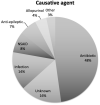Clinical Characteristics of Patients With Chronic Stevens-Johnson Syndrome Treated at a Major Tertiary Eye Hospital Within the United Kingdom
- PMID: 34109192
- PMCID: PMC8180599
- DOI: 10.3389/fmed.2021.644795
Clinical Characteristics of Patients With Chronic Stevens-Johnson Syndrome Treated at a Major Tertiary Eye Hospital Within the United Kingdom
Abstract
The purpose of this study is to provide a comprehensive review of the clinical characteristics in chronic Stevens-Johnson syndrome (SJS) patients within the United Kingdom population, their causative factors, treatment profile and prognosis. This retrospective series included 91 patients with chronic SJS treated at Moorfields Eye Hospital (London, United Kingdom). A chart review included visual acuity and presence of clinical findings (including lid abnormalities and ocular surface findings). All medical and surgical treatments were also recorded. Approximately a half of patients were White British but there were significant numbers of patients from other ethnic groups, South Asian and Black in particular. Oral antibiotics were the causative agent in almost a half of the patients with SJS, systemic infections in 14%, non-steroidal anti-inflammatory drugs in 8% and anticonvulsants in 7%. The age of onset was varied but a significant proportion of patients developed acute SJS in childhood. There was a significant correlation between visual acuity at initial referral to final recorded vision. Vision was found to continue to significantly deteriorate over time despite therapeutic interventions. Our regression model shows that ~62% of the variance in final vision can be explained by the initial vision and duration disease. The majority of our patients were on advanced ocular surface treatments including serum drops, topical ciclosporin and retinoic acid drops. Of particular significance, approximately a third of our patient cohort was also on systemic immune suppression. In conclusion, chronic SJS within the UK population under tertiary care remains an area of unmet clinical need. Current medical and surgical modalities prevent worsening of vision in severe ocular disease from SJS.
Keywords: Limbal stem cell failure; Stevens Johnson syndrome; ocular surface disease; symblepharon; toxic epidermal necrolysis.
Copyright © 2021 Jabbour, Din, Logeswaran, Taberno Sanchez and Ahmad.
Conflict of interest statement
The authors declare that the research was conducted in the absence of any commercial or financial relationships that could be construed as a potential conflict of interest.
Figures






References
LinkOut - more resources
Full Text Sources

